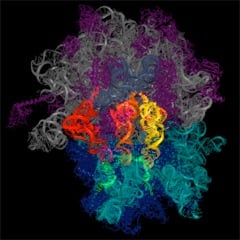Role of RNA in Protein Synthesis
In all living cells, the process of translating genetic information from DNA into the proteins that do most of the work in a cell is carried out by molecular machines made of a combination of RNA and protein. Surprisingly, it is the RNA, and not the protein, that does the critical work in this protein-making machine, which is called the ribosome. The basic shape and functional core of the ribosome is formed by RNA. The RNA has been maintained through more than a billion years of evolution: ribosomal RNA in bacteria and humans is remarkably similar. A second kind of RNA, called messenger RNA or mRNA, moves genetic information from the DNA to the ribosome. Messenger RNA provides the ribosome with the blueprints for building proteins. Amino acids are the building blocks of proteins. Each amino acid in a protein is delivered to the ribosome by yet another type of RNA: transfer RNA (tRNA). The ribosome uses the information in messenger RNA to link together the transfer RNA-bound amino acids in the correct order to make each different type of protein in the cell: human cells make nearly 100,000 different types of proteins, each with its own unique messenger RNA sequence.
 The central role of RNA in protein synthesis is illustrated by the fact that many antibiotics used to fight infections bind to the ribosomal RNA of bacteria and block the production of cellular protein. This prevents the bacteria from growing. Errors in the production or sequence of the RNA components of the protein synthesis machinery can also cause disease in humans, including, Diamond Blackfan anemia, caused by a defect in the production of ribosome, Dyskeratosis congenita, caused by a defect in ribosomal RNA structure, and some forms of diabetes, myopathies and encephalopathies due to mutations in transfer RNA.
The central role of RNA in protein synthesis is illustrated by the fact that many antibiotics used to fight infections bind to the ribosomal RNA of bacteria and block the production of cellular protein. This prevents the bacteria from growing. Errors in the production or sequence of the RNA components of the protein synthesis machinery can also cause disease in humans, including, Diamond Blackfan anemia, caused by a defect in the production of ribosome, Dyskeratosis congenita, caused by a defect in ribosomal RNA structure, and some forms of diabetes, myopathies and encephalopathies due to mutations in transfer RNA.

